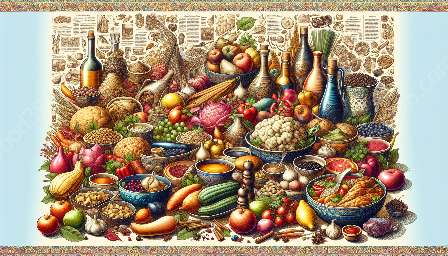Baking and pastry techniques have roots that extend deep into human history, evolving alongside cooking techniques and tools, shaping the origin and evolution of food culture. Let's explore the fascinating journey of baking and pastry from antiquity to the modern age.
The Early Beginnings of Baking
Baking can be traced back to the Neolithic era, as early humans discovered that mixing ground grains with water and exposing the resulting paste to fire yielded a palatable and easily digestible food. The first evidence of this primitive form of baking can be found in archaeological digs of ancient dwellings, where remnants of unleavened flatbreads have been discovered.
Over time, the art of baking advanced in civilizations such as ancient Mesopotamia, Egypt, and Greece. In Mesopotamia, the earliest evidence of leavened bread dates back to around 2000 BCE, demonstrating the early use of fermentation in baking. Meanwhile, the ancient Egyptians were skilled bakers, utilizing yeast as a leavening agent and developing intricate baking techniques and tools, including molds and ovens.
The Rise of Pastry Techniques
The history of pastry can be traced back to the ancient civilizations of the Mediterranean, where early pastry cooks honed the craft of creating delicate pastries and desserts. Phyllo dough, a staple in Mediterranean cuisine, was developed by the Greeks and further refined by the Romans, showcasing early pastry innovation and culinary expertise.
During the Middle Ages, pastry techniques flourished in Europe, with the development of puff pastry and the incorporation of spices and exotic ingredients from distant lands. Pastry guilds were established, contributing to the dissemination of pastry-making knowledge and techniques across the continent.
Evolution of Baking and Pastry Techniques
As societies evolved, so did baking and pastry techniques. The Renaissance period witnessed the refinement of baking and pastry, with the introduction of more complex recipes, intricate decorations, and the establishment of pastry schools and guilds. The use of sugar, introduced to Europe during the Crusades, revolutionized pastry-making, leading to the creation of new confections and desserts.
The Industrial Revolution brought about profound changes in baking and pastry, as technological advancements led to the mass production of baked goods and confections. This era also saw the proliferation of cookbooks and culinary literature, enabling the exchange and preservation of baking and pastry techniques.
The Impact on Food Culture
The historical roots of baking and pastry techniques have significantly impacted food culture. From the humble loaf of bread to the decadent pastries of European royalty, baked goods and pastries have been an integral part of feasts, celebrations, and daily meals throughout history.
Baking and pastry techniques have also influenced the development of regional cuisines, with each culture contributing its own unique baked delicacies and pastry specialties. From French croissants to Italian cannoli, the diversity of baked goods reflects the rich tapestry of global food cultures.
Conclusion
The historical roots of baking and pastry techniques have intertwined with the evolution of cooking techniques and tools, shaping the origin and evolution of food culture. From its humble beginnings in ancient civilizations to its prominence in modern culinary arts, baking and pastry have left an indelible mark on human history and continue to captivate and delight taste buds around the world.


